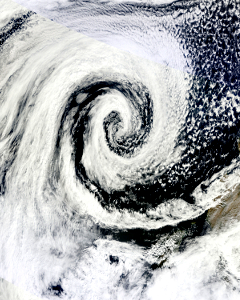Cyclone watch enhanced
 Advanced new modelling could protect vulnerable communities from flood and storm damage.
Advanced new modelling could protect vulnerable communities from flood and storm damage.
People in Fiji, New Zealand, Solomon Islands, New Caledonia, Vanuatu, Papua New Guinea, Tonga and other island nations in the Southwest Pacific will have months more to prepare for tropical cyclones, thanks to a new outlook model.
Developed by a team of climate scientists from the University of Newcastle and the National Institute of Water and Atmospheric Research (NIWA) in New Zealand, the new outlook model will generate predictions for the number of tropical cyclones at an individual country level, up to four months before the start of the tropical cyclone season.
The Southwest Pacific tropical cyclone season typically runs from November to April and the island nations and territories in this area are extremely vulnerable to tropical cyclone related impacts, including extreme and damaging winds, intense storm surge, and prolonged rainfall and flooding, which adversely affect people, infrastructure and economies.
Dr Andrew Magee from the University of Newcastle says that as current operational outlooks only offer guidance one month before cyclone season starts, the team’s findings and the new outlook model are key to ensuring more effective disaster management for tropical cyclone impacted nations and territories in the Southwest Pacific region.
“Tropical cyclones aren’t a new phenomenon and they will continue to wreak havoc across the Southwest Pacific region,” said Dr Magee.
“The provision of accurate and timely seasonal tropical cyclone outlooks are essential for informed decision making, and if we can just make small incremental steps in reducing disaster risk and informing the population of the risks associated with the coming cyclone season, then it has the potential to save lives.
“Rising sea levels and changes to tropical cyclone related exposure and vulnerability will amplify future tropical cyclone related impacts for Pacific Island nations and territories. Our new outlook plays an important role in building a more resilient future for Pacific Island communities.”
Tropical cyclones account for 76 per cent of disasters across the Southwest Pacific region, and since 1950, have claimed the lives of nearly 1,500 people and significantly impacted a further 3.1 million.
“Tropical cyclones are erratic, spatially and temporally, and every season is different. This makes it difficult for island nations and territories to prepare in the weeks and months before the official start of the tropical cyclone season,” said Dr Magee.
The new outlook model will better equip Pacific Island National Meteorological Services, government and aid agencies, decision-makers and the general public in communicating and preparing for future tropical cyclone seasons across the Southwest Pacific.
“Our tailored and bespoke tropical cyclone guidance for Pacific Island nations and territories will improve early warnings and support preparations ahead of the tropical cyclone season,” said Dr Magee.
“This will allow government and aid agencies to prepare enough supplies for the season ahead and will mean that there is more time for decision makers to communicate with communities and people on the ground, allowing for sufficient planning.”







 Print
Print